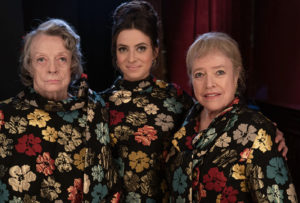“The real miracle that happens in Lourdes is not the physical healing of the afflicted.”
A friend of mine shared these words some years ago, and I could not help but think about them as I watched “The Miracle Club,” a film directed by Irish filmmaker Thaddeus O’Sullivan, which opened in the U.S. on July 14.
The film is helped by a stellar, A-list cast. As a Downton Abbey devotee, I watch anything that has “and Maggie Smith” in the opening credits. Smith’s co-stars include Laura Linney, Kathy Bates, and lively newcomer Agnes O’Casey.
While the movie is advertised as a comedy, the jokes are its weakest part. Perhaps that’s because “The Miracle Club” has something serious to say.
The story is set in the little seaside town of Ballygar, Ireland, in 1967. Four friends have been trying all their lives to raise the money for a trip to Lourdes.
Lily (Smith) has lost her only son, drowned under mysterious circumstances 40 years prior. Her friend, Eileen (Bates), has too many children instead. Her husband is a helpless brute, and she is worried about the lump she’s found in her breast.
Their younger neighbor, Dolly, (Agnes O’Casey) has a 5-year-old son who won’t speak and is at odds with her emotionally abusive spouse.
The occasion of their lives comes when their parish organizes a talent show — the first prize is a ticket for a pilgrimage to Lourdes.
The fourth member of their singing ensemble has just died: she too wanted to go to Lourdes and has begged her friends to skip her funeral to compete in the talent show.
The only person to show up at this woman’s burial is her daughter, Chrissie (played by Laura Linney), who disappeared from Ireland 40 years prior and has not been back since. No one is happy to see her, especially her mother’s friends.
Lily, Eileen, and Dolly get second prize, but the first-prize winner lets them take the tickets in his place. As they are waiting to depart, Chrissie dramatically appears in front of the bus, a suitcase in her hands.
In Lourdes, the backstory of the four central characters is uncovered bit by bit, and we begin to understand why these women hate one another so much.

“The Miracle Club” does have some flaws. The scenes in Lourdes are noticeably green-screened; clearly no member of the cast set foot in France for the shooting.
In terms of writing, there are some holes, too.
Why on earth does Chrissie, who has no interest in religion, decide last minute to go to Lourdes with a group of ladies who hate her? Can we really believe that Lily has waited 40 years to ask Chrissie what happened to the baby she was carrying (her grandson)?
Despite these hiccups, the film’s real lesson begins to take shape while they are on pilgrimage. Eileen is upset to learn that only 62 miracles have been certified since the shrine’s opening. Like the other women, she gets no benefit from bathing in the sanctuary’s miraculous waters.
So what kind of miracle is this movie about?
In 1989, Danila Castelli became the recipient of one of the last certified miracles that happened in Lourdes (the 69th). When she got to the French shrine, she was terminally ill.
She did not go to Lourdes to find physical healing, but to find the courage to face death. As she said in a 2013 interview to Italian newspaper Avvenire, she wanted to find peace at the end of her journey: “I wanted to forgive and be forgiven.”
“During the bath [in the holy waters] I felt an immense joy,” she added. “As I got out from the pools, I met my husband, who had accompanied me: he too was at peace, and he told me that he had forgiven it all. So I understood that that was the real healing, the end of resentment; the physical part was just a sign of the gift God had given me.”
That is the type of healing this movie is about. The four women in “The Miracle Club” carry a big cross. They have made tragic mistakes, they have hurt one another. They cannot forgive others and cannot forgive themselves. And they have kept all this inside of them for too long.
The miracle that the Virgin Mary does is to put them on the same trip together, and provide them with the grace of reconciliation — with themselves and one another.
When they go back to their town, nothing external has changed — their husbands are no less useless than they were before.
But they have changed: They are now ready to accept the reality in which God has put them, and to live it with joy.
As Danila Castelli said, “It is possible to live joyfully amidst suffering: the Lord gave me this gift when I was sick, because he does the impossible.”
Toward the end of the film, I found myself wondering what it would be like if God put me on a trip with all those I have hurt in my life, thinking about those who would sit on that bus. I do hope that, like the characters in this movie, I will get more than once the opportunity to reconcile. After all, we do not need to go to Lourdes to experience its real miracle.

